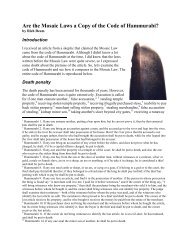Coming to Grips with the Early Church Fathers - Evidence for God ...
Coming to Grips with the Early Church Fathers - Evidence for God ...
Coming to Grips with the Early Church Fathers - Evidence for God ...
Create successful ePaper yourself
Turn your PDF publications into a flip-book with our unique Google optimized e-Paper software.
<strong>Coming</strong> <strong>to</strong> <strong>Grips</strong> <strong>with</strong> <strong>the</strong> <strong>Early</strong> <strong>Church</strong> Fa<strong>the</strong>rs’ Perspective on Genesis John Millam<br />
Allegory vs. Allegorical Interpretation<br />
To understand what is meant by allegorical interpretation, we need <strong>to</strong> draw a clear distinction<br />
between that and plain allegory. Allegory is a figurative or symbolic representation referring <strong>to</strong> a<br />
meaning o<strong>the</strong>r than <strong>the</strong> literal one. Certain passages of Scripture contain allegory, as well as<br />
o<strong>the</strong>r figures of speech, which can be unders<strong>to</strong>od using <strong>the</strong> normal rules of interpretation. For<br />
example, Paul uses an allegory based on Hagar and Sarah (Galatians 4:21–31) <strong>to</strong> illustrate why<br />
<strong>the</strong> Galatians should not listen <strong>to</strong> <strong>the</strong> Judaizers.<br />
Allegorical interpretation, on <strong>the</strong> o<strong>the</strong>r hand, involves looking <strong>for</strong> a symbolic or figurative<br />
meaning beyond or instead of <strong>the</strong> literal/his<strong>to</strong>rical one. One extreme example comes from Philo,<br />
where he interprets allegorically <strong>the</strong> cherubim guarding <strong>the</strong> entrance <strong>to</strong> Eden (Genesis 3:24) as<br />
representing <strong>the</strong> two hemispheres of heaven (On <strong>the</strong> Cherubim 7–8). The key difference between<br />
allegory and allegorical interpretation is that <strong>for</strong> <strong>the</strong> <strong>for</strong>mer <strong>the</strong> meaning is found in <strong>the</strong> text itself<br />
while <strong>the</strong> latter looks beyond <strong>the</strong> text and relies heavily on <strong>the</strong> ingenuity of <strong>the</strong> interpreter.<br />
His<strong>to</strong>rical Background on Allegorical Interpretation<br />
Allegorical interpretation of Scripture first gained prominence among <strong>the</strong> Hellenistic (Greekspeaking)<br />
Jews of Alexandria, Egypt, starting around <strong>the</strong> second century BC. (Philo of<br />
Alexandria, whom I mentioned earlier, is <strong>the</strong> most prominent example of this group.) Alexandria<br />
represented one of <strong>the</strong> largest Jewish communities living outside of Israel; it was also a major<br />
center of Greek learning. The Jews <strong>the</strong>re were caught between engaging <strong>the</strong> surrounding Greek<br />
culture and remaining faithful <strong>to</strong> <strong>the</strong>ir own.<br />
In three different ways allegorical interpretation played an important role in helping <strong>the</strong><br />
Hellenistic Jews find a balance between <strong>the</strong>se two different worlds. First, it provided a way <strong>to</strong><br />
apply Scripture passages <strong>to</strong> <strong>the</strong> audience’s non-Jewish context. Second, it allowed writers <strong>to</strong><br />
comment on Greek ideas not directly discussed in Scripture. In <strong>the</strong> example I mentioned earlier,<br />
Philo used <strong>the</strong> cherubim as a springboard <strong>to</strong> write about <strong>the</strong> nature of <strong>the</strong> heavens. Third, some<br />
parts of Scripture seemed meaningless or even absurd <strong>to</strong> a Gentile audience. Allegorizing <strong>the</strong>m<br />
would help blunt those objections.<br />
It was in Alexandria that this mode of interpretation eventually crossed over in<strong>to</strong> Christianity.<br />
Alexandria was a major intellectual center <strong>for</strong> early Christendom <strong>with</strong> an important catechetical<br />
school located <strong>the</strong>re and of which both Clement and Origen served as headmasters in <strong>the</strong>ir day.<br />
Allegorical interpretation served a similar purpose in <strong>the</strong> early church as it had among <strong>the</strong><br />
Hellenistic Jews because <strong>the</strong>y <strong>to</strong>o were surrounded by Greco-Roman culture. Even more, <strong>the</strong><br />
early church—including all of <strong>the</strong> church fa<strong>the</strong>rs—was itself almost entirely non-Jewish <strong>with</strong><br />
little knowledge of <strong>the</strong> Hebrew language or Jewish culture. 13 So, <strong>the</strong> Old Testament as plain<br />
Jewish his<strong>to</strong>ry would have had little meaning <strong>to</strong> <strong>the</strong> church fa<strong>the</strong>rs or <strong>the</strong>ir listeners.<br />
Origen was <strong>the</strong> leader in popularizing allegorical interpretation. Even more, he codified it in his<br />
three-fold method of interpretation (First Principles 4.1.11–13). In his system, interpretation<br />
occurred on three different levels paralleling <strong>the</strong> tripartite nature of man (body, soul, and spirit).<br />
The first level of interpretation is <strong>the</strong> “body” representing <strong>the</strong> plain literal (obvious) meaning;<br />
13. In contrast, <strong>the</strong> apos<strong>to</strong>lic church (c. 30–90 AD) had been primarily Jewish in composition and centered in<br />
Jerusalem. The change over from Jewish <strong>to</strong> Gentile adherents occurred very rapidly between about AD 70–150.<br />
Page 5 <strong>Evidence</strong> <strong>for</strong> <strong>God</strong> from Science






